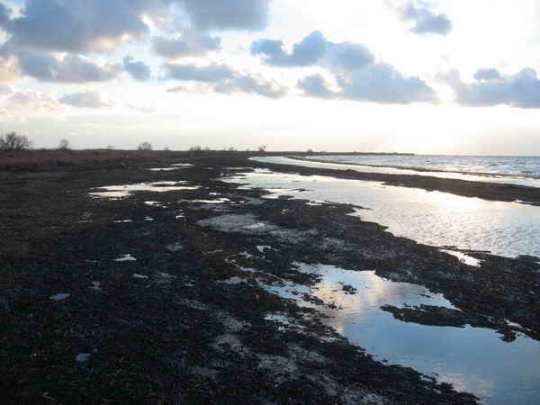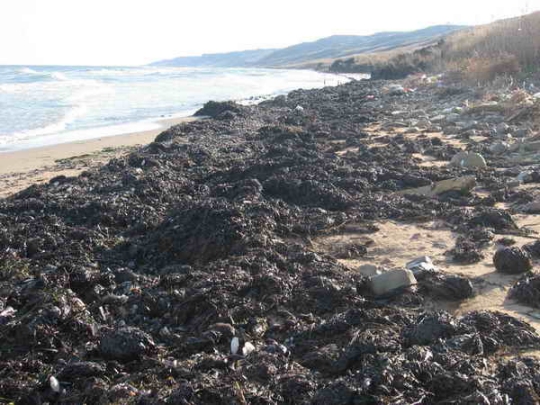Activists from Environmental Watch “Break Through” to South Chushka
As before, banks of the Azov Sea on the Taman Peninsula are covered in fuel oil.
On November 28, activists from Environmental Watch on the North Caucasus, together with several volunteers who came from Taman in order to save birds and clean up the shoreline, continued to monitor the situation along the seashore of the Taman Peninsula, following the environmental catastrophe in the Strait of Kerch. Russian and Ukrainian authorities had turned down their help.
In spite of the ongoing strict restrictions on access to the southern part of the Chushka Spit to environmental public organizations, three activists from Watch and two volunteers were able to go there in the afternoon of November 28. They monitored the entire western bank of this part of the Spit for the five kilometers from the Port of Kavkaz to the southern tip, from where the Dzendzik Island is visible.
The reason that the authorities don’t want to let “greens” go there is very simple. As the observation of the seashore demonstrated, the cleanup of this part of the Spit, which was only started last week, is still in the very beginning stages. No more than 500 meters of the five kilometers of South Chushka has been cleaned. And ten days ago, when Environmental Watch activists were here the first time, 20-30 meters of the beach was covered with thick blankets of spilled fuel oil. The number of people and technical assistance involved with the cleanup of the beach is critically low. At this rate, it will take another several months to clean this part of the Spit. As workers stated, no cleanup work has taken place at all on Dzendzik Island.
The southern part of the Chushka Spit is one of the most environmentally valuable areas that has suffered from the catastrophe on the seashore. A vast area of flood plains and islands, with a large, concentrated population of birds, is located here. During the examination of the territory, on the beach and along the road we saw several oiled birds, including one swan that was completely covered with oil. However, as workers involved in the beach cleanup stated, thousands of oiled birds continue to suffer in the reed-enclosed flood plains.
On this day also, activists from Environmental Watch and the volunteers traveled along the entire polluted shore of the Sea of Azov between the village of Priazovsk to the Port of Kavkaz. The situation in this expanse of around 25 kilometers, just as along Southern Chushka, was much worse than expected.
In conjunction with the data from observations of the seashore that were conducted on November 27, it was clear that the seashore of the general expanse of 15 kilometers between the villages of Ilyich and the Cape of Pekla has not been cleaned by anyone, except the activists from Greenpeace Russia. The beach in this area is extremely polluted by petroleum products. Many dead birds can be found in some parts of the shore. And, no live oiled birds were seen on this part of the beach.
The situation in this area is no better than it was on November 19, when activists from Environmental Watch were here the first time. Instead, a more complete observation of the territory indicated that the section of the shore between the village of Ilyich and the Cape of Akhilleon is completely uncleaned, in comparison to the earlier impression that it had been cleaned up. In total, the length of the Azov shoreline on the Taman Peninsula that has not been touched by the hands of the liquidators of the impacts of the catastrophe is over 15 kilometers.
But what became more understandable during the monitoring was that several kilometers of beach have become seriously polluted with fresh fuel oil on the northern part of the Chushka Spit, an area that was actively cleaned up earlier. Now, it seems as though this area, which was already cleaned up completely has not been cleaned up at all.
Only along the way to the Port of Kavkaz on the banks of the spit, did activists came across equipment and about one hundred working soldiers, who were cleaning up secondary fuel oil waste on the beach. Oiled birds were not visible, and the impression was that they had all been killed. However, this was not the case. Earlier, local residents told Environmental Watch that many birds that had been covered with fuel oil were walking along the road to the Port of Kavkaz, and as a result, many of them had been run over. This information was confirmed. On the east bank of the Chushka Spit, facing the Dinsk Gulf, a massive accumulation of oiled birds was observed. There were a lot of them, even two weeks after the catastrophe. In an area of 12 kilometers between the village of Ilyich and the Port of Kavkaz, they wandered in large groups along the road and hid in the shoreline rushes. It was not clear if the birds had been able to survive this long since the accident, or if they had only recently been oiled. Several thousand suffering birds were in difficulty in this area. All the birds noticed in this area were coots. It was clear that this species is quite hardy. The birds have very little chance of survival, however, because of the onset of continuous frost. Unfortunately, the activity by public organizations to save birds is no longer operational, primarily because of the unwillingness of the power structures top provide assistance in carrying it out.
On the whole, the results of the independent monitoring undertaken by Environmental Watch showed the complete deception by officials that the liquidation of the catastrophe is complete. In the observed area of the polluted shoreline from the southern tip of the Chushka Spit to the Cape of Pekla, the overall expanse of which is about 35 kilometers, only a small part has undergone the necessary work for the cleanup of the beach. And, only the minimum amount has been done. On November 28, activists from Environmental Watch counted no more than 300 people who were cleaning up the beach. According to official data, 1250 people were involved in cleanup work on the Chushka Spit.
Severe winter weather is fast approaching, when cleanup of the coastline of the Taman Peninsula will be practically impossible. In this connection, the Commission for the liquidation of the impact of the storm in the Strait of Kerch will have to stop feeding everyone the lie that the situation has “become procedural” and immediately undertake a real, full-scale operation to clean the entire oiled beach, rather than continuing small demonstration cleanup actions on specific areas of the beach.
Andrey Rudomakha
Environmental Watch on the North Caucasus
Environmental Watch on the North Caucasus
Information Distribution
November 28, 2007
For more information:
Tel: (8772) 540607
Email: ies@nullrambler.ru
More recent information about the catastrophe in the Strait of Kerch, including photographs, is available on our site:
www.blacksea.ewnc.org
Information on the site is updated daily.
Translation by Crude Accountability




